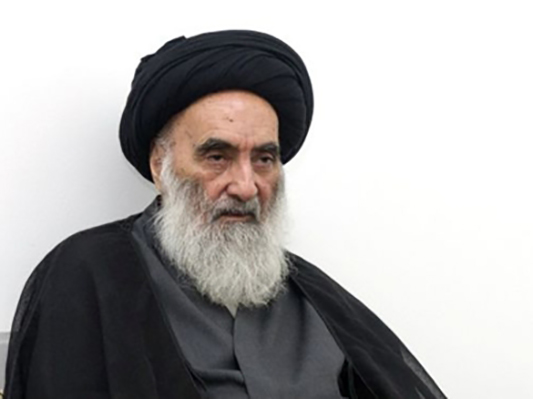In a recent report, the famous French newspaper Le Monde described Ayatollah Ali al-Sistani, the grand religious leader of Iraqi Shiites, as the most influential figure in this country: a man whose absence will leave a large void in Iraq.
“Ayatollah Ali Al-Sistani receives his visitors at his place; on a modest bench in an almost empty room of his decrepit office in the old town of Najaf; a humility commensurate with his power. This man has no equal in Iraq, nor in the entire Shiite world: his aura extends from Iran to Lebanon, from Afghanistan to India, and to South Asia,” wrote Le Monde.
“In Baghdad, the rulers bow before the edicts of this taciturn clergyman who openly blames their corruption, impotence and turpitude.”
“He never speaks in public, nor receives the press,” Le Monde added. “His relatives update him on latest news, which he follows carefully.”
“His skin is gray and his face is covered with a white beard, under the black turban of the descendants of Prophet. One day he will die. The seminarians of Najaf regularly evoke his succession: his death will be a large void in a country already at war. The Shiite people love and revere him; Sunni leaders respect him. He is a bulwark against sectarian hatred, a crutch for the collapsing Iraqi state.”
“Ali Al-Sistani acquired his aura in April 2003, when the US invasion put an end to Saddam Hussein’s thirty-four years of reign. Najaf was then a bleeding town. Persecuted by the Baathist regime, its clerics had fled from the heart of Shi’ism, the mausoleum of Imam Ali [AS] – the first imam of the Shiites – to take refuge in Qom, Iran. The seminaries were filled with shadows. Ayatollah Sistani, who was living in quasi-house arrest, did not teach at that time. He had published no work, had no political expression. But was already, by far, the most followed among the marja-e taqlids, top Shiite religious leaders,” Le Monde added.
According to a Farsi report by Fars News Agency, Sayyed Ali Hosseini Sistani was born in Mashhad, Iran. He became the head of Najaf seminaries after the demise of Ayatollah Sabzevari. Then he became famous in Iraq, Persian Gulf countries, India and Africa, among the youth in particular.
He began to appear at the top of news after playing a key role in unity and security of Iraq after US invasion of the Arab country in 2003.
